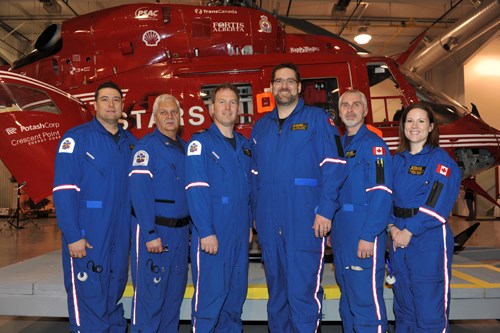If you look up into the Saskatchewan skies and see a helicopter speeding by, you are not going crazy, nor are you under surveillance. It is just the STARS (Shock Trauma Air Rescue Society), team flying by to another medical emergency.
STARS has flown more than 22,000 missions across Alberta and BC. Every second is important in an emergency when someone is facing life-threatening issues. The quicker patients receive care, the better chance they have of surviving and recovering.
"I am really proud that STARS can play a part in these situations," said Kelly Brossart, public relations and communications person for STARS.
The charitable, non-profit organization started it's services in Alberta in 1985, from bases in Calgary, Edmonton and Grande Prairie. In 2011 they began responding to cases in Manitoba and began service from Regina April 30, 2012.
The first call that the Regina crew responded to, was right in our own backyard!
On the second day of operations, the air ambulance received an emergency call at about 3:30 p.m. The call was a medical emergency near Kenosee Lake. Ground-based medical services took a patient to the hospital in Arcola where the helicopter was then used to transport the patient to Regina where another EMS team met the helicopter and took the patient to the General Hospital.
" It took STARS 50 minutes from the time they lifted off to landing in Arcola," said Brossart. " The helicopter cuts off a huge amount of the time it takes to get the patient to a hospital equipped to deal with their situations."
Since the initial emergency rescue, STARS has responded to three other calls in a variety of different Saskatchewan towns.
STARS is beginning with a daylight hour schedule in Regina working 7 a.m. to 7 p.m., and will gradually work towards 24 hour a day rescues later in the summer. This is to increase the comfort level with providing service in an air medical environment when the majority of clinical and aviation staff are new. This provides the safest environment for both the patients and the STARS team.
On each rescue mission, the STARS helicopter is staffed with two pilots and the air medical crew, including an advanced care paramedic and a critical care nurse. An emergency physician trained in pre-hospital care and transportation is also available by telephone for every emergency response and will travel with the crew if thought to be medically necessary.
On top of the medical graduate degrees required, the crew must have a minimum of 36 hours per month as an air medical crew member, as well a minimum of 30 hours of continuing education per year is required to maintain competency.
If this is something that interests you, keep in mind that you also will be required to complete the STARS academy, which is a 12-week intensive training program.
Ideally, the BK-117 helicopter flies to a hospital or incident scene and returns without refuelling, a maximum distance of approximately 500 km round-trip (250 km to the scene and 250 km back). In some special emergency situations, STARS will fly beyond this refuelling radius in order to assist with patient care and transport and will have to refuel mid-flight.
"We are here to insure the best possible outcome for a patient," Brossart explained with pride. "I've often heard the aircraft described as a travelling ICU. We're just one link in that chain of survival."
As a non-profit organization, the provincial government of Saskatchewan has invested $5 million in 2011-12 with approximately $10 million to continue each year in the future. The remainder of the funds will have to come from STARS fundraising efforts, including contributions from the community and corporate sector.
" We are looking forward to next week announcing a Saskatchewan lottery, stay tuned for details on that, and a number of other secret events." concluded Brossart.




